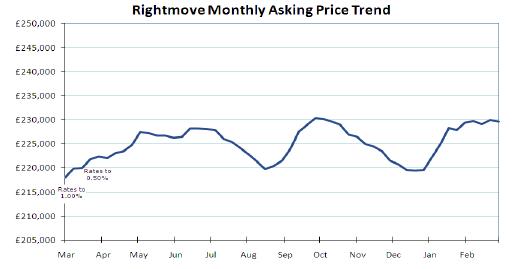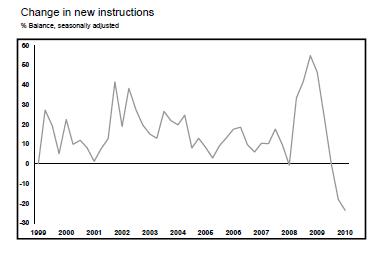More home sellers, fewer home letters – a housing market in flux
How should we read yesterday’s Rightmove figures showing the slowest ever March pick up in asking prices?
They appear to be consistent with much of what else we are seeing in the market – a growing body of evidence that the recent bounce back in the housing market is faltering (see previous blog).
 The key factor slowing the rise in asking prices (see graph) Rightmove isolated was a rise in properties coming onto the market – up 34% on the same period a year ago.
The key factor slowing the rise in asking prices (see graph) Rightmove isolated was a rise in properties coming onto the market – up 34% on the same period a year ago.
Well in assessing what this means, firstly, I wouldn’t put too much store by one or two months’ asking price data, particularly when we have had so many queering factors, such as heavy snow and the ending of stamp duty relief, freaking the figures.
Secondly, I would tend to look at other data to get a view of what might be going on from another perspective.
 So let’s look at the release of the RICS residential lettings survey, out today (see graph). This is useful because in many respects the lettings side is the flip of the home sales market.
So let’s look at the release of the RICS residential lettings survey, out today (see graph). This is useful because in many respects the lettings side is the flip of the home sales market.
And interestingly it too suggests that the market is shifting. Rents are stabilising – good for landlords, but new landlord instructions are falling – bad for lettings agents. The story here is that there is less property going into the lettings market.
Is it a coincidence that there fewer less letting instructions and more selling instructions?
Before considering that, it is worth reflecting that in an abnormal market such as we are currently experiencing, small changes can have a magnified effect.
So could it be that we are seeing an increase in former landlords, the so-called reluctant landlords among them, offloading property now that prices have risen and rents have fallen for some while?
Certainly there has been much in the press since the banking crisis about buy-to-let landlords divesting themselves of their portfolios, with Judith and Fergus Wilson getting regular spots in the finance and feature pages.
And the RICS survey clearly shows how much less attractive letting has become with gross yields an average negative for the past year.
Perhaps now that prices have risen, later arrivals to the market may just be in a position to bail without taking a nasty hit on their investments and are taking the opportunity to cash in now fearing that house prices may slip back again.
All this probably is happening to some degree or another and it probably means more stock coming onto the market, which in turn probably means asking prices are checked.
But in reality, unless we see more evidence of a flood of former rental homes go up for sale, this would be just one factor among many that will be driving change in the current crazy house market.
And there will be many other “local” factors influencing the housing market, such as the weird weather and shifts in mortgage availability.
But what will eventually shape the market in the medium-term from where we stand now will be the huge economic factors, such as interest rates and employment prospects. And here the picture is littered with risks and uncertainty.
Despite the sense of easier times within the economy that we may have felt of late, we are far from out of the woods.
In casual conversations on the state of the economy I am constantly taken aback by how many people appear to ignore the current context and, uncluttered by that inconvenience, consider the worst to be over. But we have seen:
- A monetary boost of £200 billion through QE. This will at some stage be halted and go into reverse
- Bank of England interest rates at 0.5%. It seems inconceivable to think that rates as low as this might be sustainable for very long
- Almost £200 billion of financial support from the Bank of England through the Special Liquidity Scheme. The Bank is adamant its three-year time limit must be met
- Huge sums of Government spending pumped through the economy. The effects of this will come to an end and will be reversed dramatically
- The value of Sterling drop by 25% on a trade weighted basis since September 2007.
This is an exceptional and extreme, albeit appropriate, economic response to the crisis faced by the global economy and in particular the UK economy.
However, the succour provided cannot be sustained indefinitely nor repeated time and again. These are economic palliatives and restoratives (some argue with very nasty side effects).
We will see the support end and then eventually at some point much of the monetary and fiscal stimulus will be reversed.
Encouragingly, the support provided appears to have encouraged employers to maintain a more flexible approach to employment levels than they might have taken in past recessions.
Comparative data with other recessions is hard to come but the level of underemployed has risen sharply during the past year or so. An article in a recent Economic & Labour Market Review caught my eye. It calculated that underemployment (broadly those obliged to work fewer hours than they would like) rose by best part of 600,000 in the year to Q3 2009.
Although this is no direct measure, it does fit with employers’ willingness to hold onto people through shortening hours, or unpaid sabbaticals or longer unpaid holidays. In part it may also help to explain the rather puzzlingly muted level of unemployment in the face of the severe downturn in output.
All very good, but for two linked thorny questions: How much of this is labour hoarding by employers expecting a swift recovery? What if the recovery fades, will we see a rapid increase in unemployment?
If there is labour hoarding, while this reduces short-term pain and hopefully will prove sensible long-term, it greatly increases the fragility of the labour market, as each person “hoarded” at low rates of productivity attracts a pretty much fixed overhead as well as time-related earnings.
Certainly at a recent Bank of England supported Monetary Policy Roundtable there was a real sense of uncertainty over the labour market judging by the report (see page 56 of the quarterly bulletin).
The future path of interest rates is uncertainty too. The general view is that they will remain low for some while.
This may prove true, however the path of inflation remains uncertain and there are many arguing that the upward pressures are greater than the Bank of England’s assessment. If this proves correct it will most likely require swift action from the Bank in the form of earlier than expected rises to interest rates.
With many mortgage holders already stretched financially, there remains questions over how resilient the will be and whether the impact of mortgage rate rises will spark a new wave of defaults.
As with unemployment, the policy path chosen has led to a reduced rate of repossessions.
But this does not mean that there is no underlying fragility.
Frankly the housing market will remain skating on thin ice for some many months yet. Who knows if the ice will break?